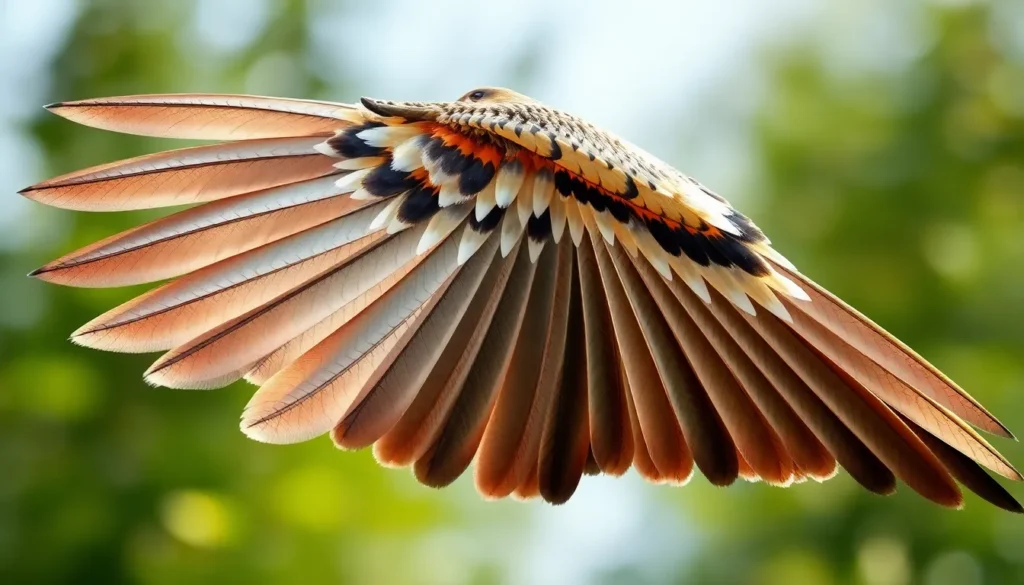Birds possess one of nature’s most remarkable engineering marvels – their wings. We’ve all watched in awe as eagles soar effortlessly through mountain thermals or hummingbirds hover with impossible precision at our feeders. But what makes these incredible feats of flight possible lies in the intricate anatomy hidden beneath those beautiful feathers.
Understanding bird wing anatomy reveals the sophisticated biological machinery that’s evolved over millions of years. From the hollow bones that provide strength without weight to the complex arrangement of flight feathers that create lift and thrust, every component serves a crucial purpose in the physics of flight.
We’ll explore how different wing shapes enable various flight styles, examine the muscular systems that power wing beats, and discover why certain anatomical features make some birds masters of migration while others excel at aerial acrobatics. This intriguing area of avian engineering will transform how you view every bird that crosses your path.
Basic Structure of Bird Wing Anatomy
Bird wings consist of three distinct anatomical regions that work together to create lift and enable controlled flight. We examine these fundamental components to understand how avian flight mechanics operate across different species.
Primary Wing Components
The wing structure contains three main segments that mirror the basic vertebrate limb pattern. We identify the humerus as the upper arm bone that connects to the bird’s shoulder joint and provides the primary attachment point for flight muscles. The radius and ulna form the forearm section where secondary flight feathers attach along the trailing edge.
Flight feathers divide into two categories based on their location and function. Primary feathers attach to the hand bones and digits to generate forward thrust during the downstroke. Secondary feathers connect along the ulna bone and create the wing’s lifting surface during flight.
The wing’s skeletal framework includes specialized adaptations that reduce weight while maintaining strength. Pneumatic bones contain air spaces connected to the respiratory system and decrease overall body mass by 20% compared to solid bone structures. Fusion occurs between hand bones to create a rigid carpometacarpus that supports the primary flight feathers.
Muscle groups control wing movement through a complex arrangement of tendons and ligaments. The pectoralis major provides the powerful downstroke motion and comprises up to 35% of total body weight in strong flying birds. The supracoracoideus muscle creates the upstroke through a pulley system that redirects force over the shoulder joint.
Wing Shape Variations Across Species
Wing morphology reflects exact flight requirements and ecological niches across bird species. We observe four primary wing shapes that correspond to different flight strategies and environmental adaptations.
Elliptical wings appear in forest dwelling birds like sparrows and woodpeckers that require quick acceleration and tight maneuverability. These wings feature rounded tips and high aspect ratios that enable rapid takeoff from confined spaces. The wing loading remains low at 0.3 to 0.8 grams per square centimeter to help hovering and precise navigation through dense vegetation.
High aspect ratio wings characterize soaring birds such as albatrosses and petrels that spend extended periods gliding over open water. These wings measure 3 to 4 times longer than their width and reduce induced drag by 60% compared to shorter wing designs. The narrow profile minimizes energy expenditure during long distance travel and oceanic foraging flights.
Swept back wings occur in high speed birds including falcons and swifts that pursue prey through rapid diving or continuous flight. The pointed wing tips and backward angle reduce air resistance at velocities exceeding 60 miles per hour. Wing loading increases to 1.5 to 2.0 grams per square centimeter to maintain structural integrity during high speed maneuvers.
Broad wings with slotted tips define soaring raptors like eagles and hawks that use thermal currents for lift. The wide wing span creates maximum surface area for catching rising air masses while wingtip slots reduce turbulence and increase efficiency. These adaptations allow birds to remain airborne for hours with minimal energy expenditure.
Feather Types and Their Functions
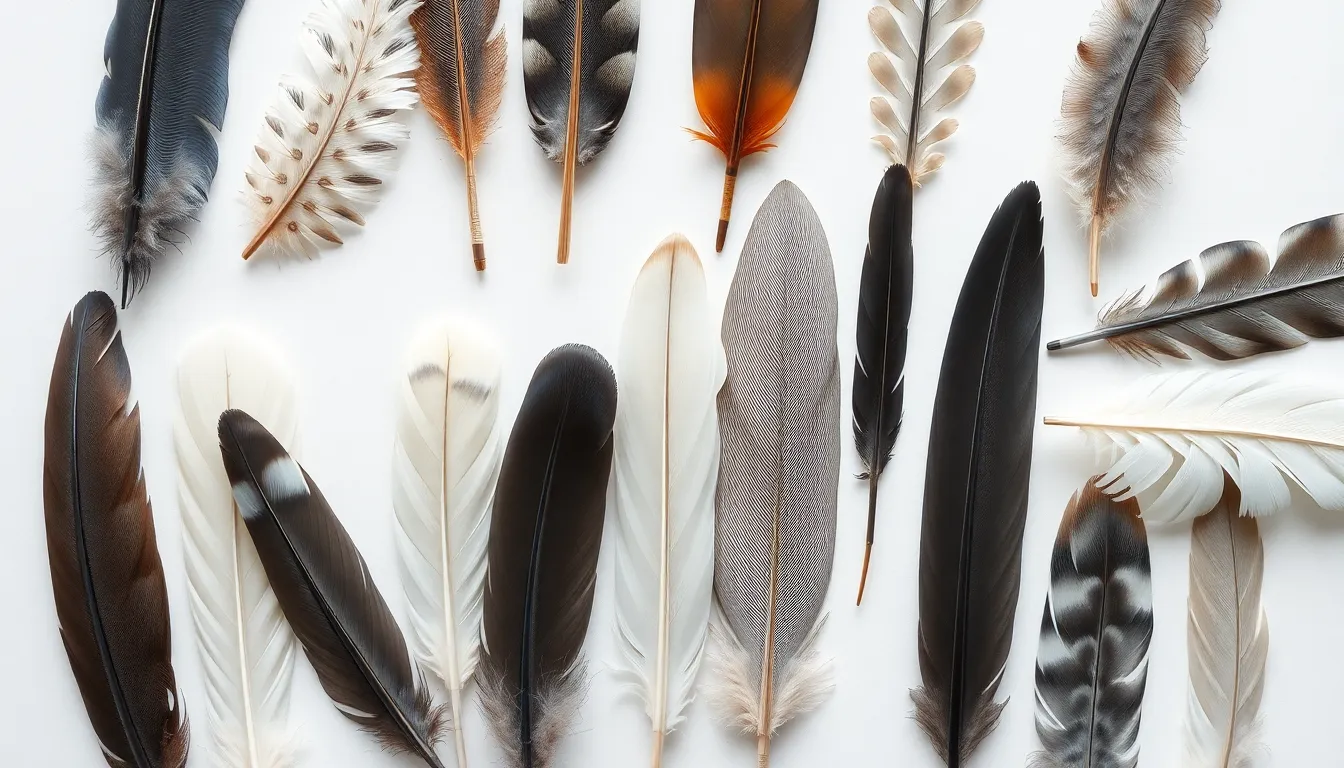
Birds possess specialized feather types that work together to create the aerodynamic surfaces essential for flight. Each feather category serves distinct functions in lift generation, flight control, and body protection.
Flight Feathers
Flight feathers represent the most critical components of bird wing anatomy for generating lift and thrust. Primary flight feathers attach to the manus (hand bones) and create the wing tip’s cutting edge, with 9-12 feathers per wing in most species. These feathers produce thrust during the downstroke and help birds maneuver through precise adjustments.
Secondary flight feathers connect to the ulna bone and form the wing’s inner trailing edge. Species like eagles possess 12-25 secondary feathers that generate lift by creating the wing’s cambered shape. The asymmetrical vane structure of flight feathers creates aerodynamic efficiency, with the narrow leading edge cutting through air while the broader trailing edge provides surface area.
Tertiary feathers fill the gap between secondary feathers and the bird’s body. These feathers smooth airflow over the wing’s base and prevent turbulence that could reduce flight efficiency. Flight feathers undergo molting cycles that replace worn feathers systematically, ensuring birds maintain flight capability throughout the process.
Contour and Down Feathers
Contour feathers create the streamlined outer surface of bird wings and bodies. These feathers overlap like shingles to form smooth aerodynamic profiles that reduce drag during flight. Wing coverts, a type of contour feather, cover the bases of flight feathers and create seamless transitions between different feather layers.
Down feathers provide insulation beneath contour feathers but also contribute to wing function. Semiplume feathers combine characteristics of both down and contour feathers, filling spaces between major feather tracts. These feathers help maintain wing shape under varying air pressures and flight conditions.
Specialized contour feathers called alula feathers attach to the bird’s thumb bone. The alula functions like an aircraft’s leading edge slat, creating controlled airflow separation that prevents stalling during slow flight or landing approaches. Birds can independently control alula position to fine tune their flight performance in different situations.
Skeletal Framework of Bird Wings
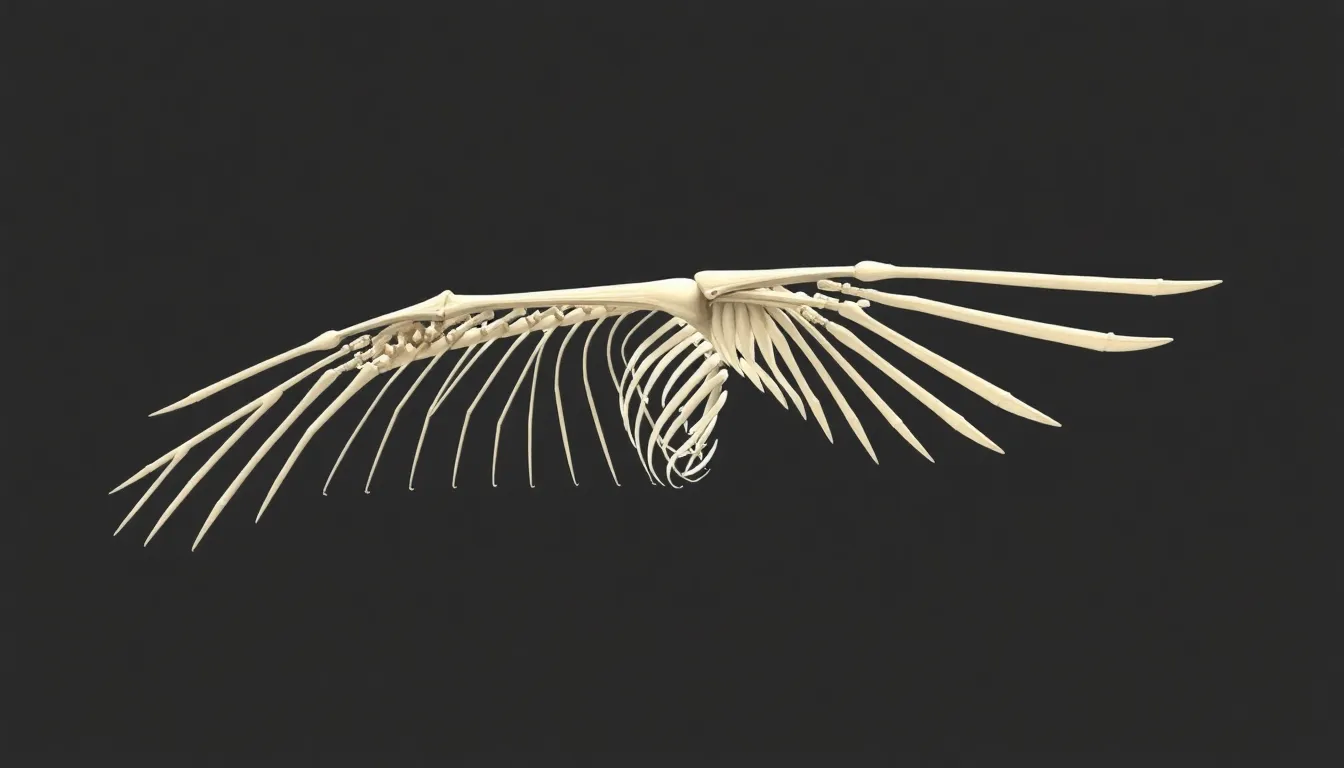
The skeletal framework forms the structural foundation that supports bird wing anatomy and enables controlled flight mechanics. This framework consists of lightweight yet strong bones connected by flexible joints that allow precise wing positioning during various flight maneuvers.
Wing Bones and Joints
Wing bones create the primary structural elements that anchor flight feathers and provide attachment points for powerful flight muscles. The humerus connects the wing to the body at the shoulder joint and houses pneumatic chambers that reduce overall weight while maintaining strength.
The radius and ulna form the forearm section and work together to create the wing’s middle segment. These bones feature specialized grooves where secondary flight feathers attach and generate the wing’s primary lifting surface. The carpometacarpus represents the fused hand bones that extend the wing’s length and support the crucial primary flight feathers.
Joint flexibility allows birds to adjust wing angles and shapes during different phases of flight. The shoulder joint provides the greatest range of motion and enables the powerful downstroke and upstroke cycles. The elbow joint allows wing folding and extension while the wrist joint fine tunes feather positioning for optimal aerodynamic performance.
| Bone Component | Primary Function | Weight Reduction Feature |
|---|---|---|
| Humerus | Wing attachment to body | Pneumatic chambers |
| Radius | Forearm support structure | Hollow interior |
| Ulna | Secondary feather anchoring | Reduced cortical thickness |
| Carpometacarpus | Primary feather support | Fused bone structure |
Adaptations for Flight Mechanics
Adaptations in bird wing skeletal structure directly correspond to exact flight requirements and ecological niches. Pneumatic bones contain air spaces connected to the respiratory system and reduce skeleton weight by up to 20% compared to solid bone structures.
Bone density varies across species based on flight patterns and body size requirements. Soaring birds like albatrosses have proportionally longer wing bones with enhanced pneumatization while rapid fliers like falcons feature denser bones that withstand high speed stress forces.
Fusion patterns in wing bones eliminate unnecessary joints and create rigid flight surfaces. The carpometacarpus results from fusing multiple hand bones and creates a single strong unit that supports primary flight feathers during powerful wing beats. This fusion prevents energy loss through joint flexibility while maintaining essential structural integrity.
Specialized bone textures provide enhanced muscle attachment surfaces that generate greater flight power. Ridges and crests on the humerus anchor the massive pectoralis muscles while the coracoid bone creates a strut that braces the wing against the powerful forces generated during flight.
Muscle Systems and Wing Movement
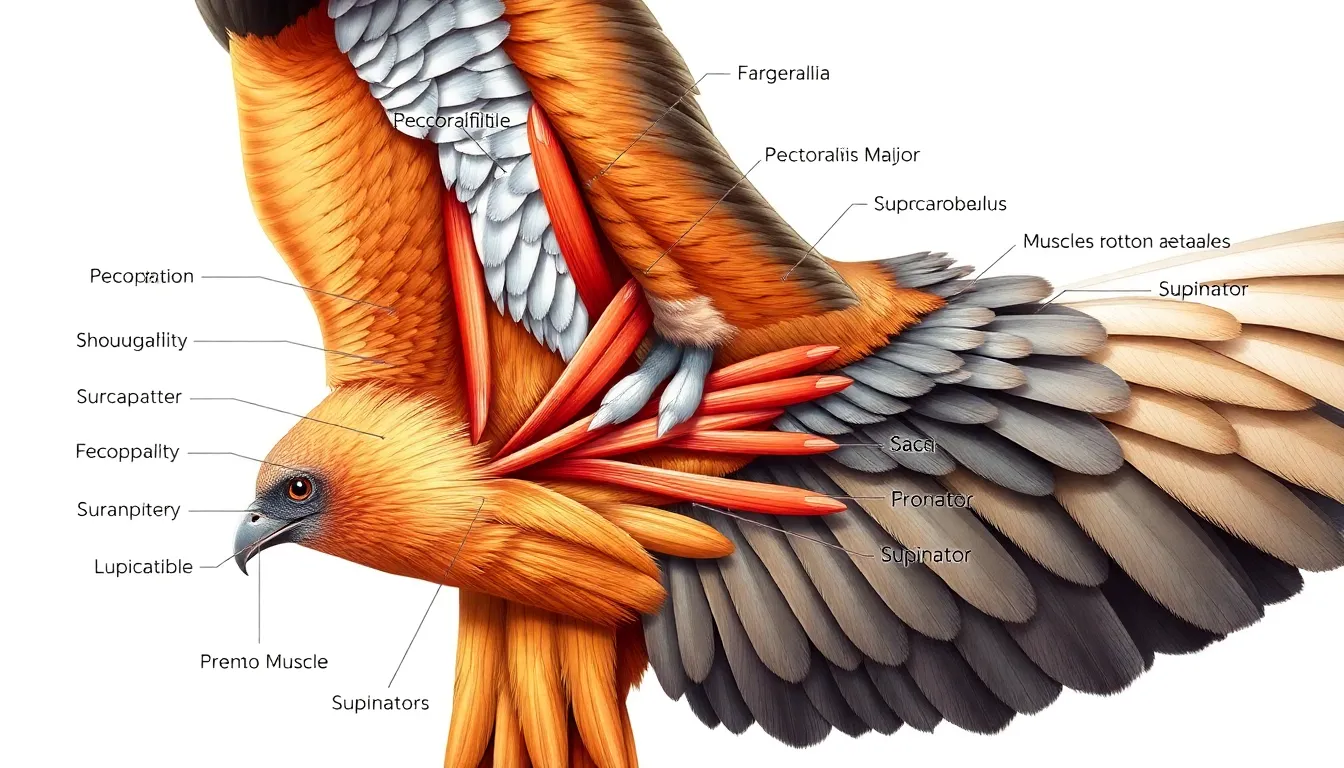
Bird wing anatomy muscle systems transform skeletal framework into ever-changing flight machinery through coordinated contractions. These powerful muscular networks generate the precise movements that enable birds to achieve lift, thrust, and intricate aerial maneuvers.
Primary Flight Muscles
Pectoralis major muscles dominate bird flight mechanics by providing the primary downstroke power that generates thrust and lift. Located on the breast, these massive muscles account for 15-25% of total body weight in most flying birds and attach directly to the humerus via strong tendons. During the downstroke phase, pectoralis major contracts forcefully to pull wings downward and forward, creating the essential power stroke for flight.
Supracoracoideus muscles execute the upstroke by lifting wings through an ingenious pulley system that passes through the foramen triosseum. This smaller muscle group, positioned beneath the pectoralis major, weighs approximately 10% of the pectoralis major but performs the critical function of wing elevation. The supracoracoideus attaches to the top of the humerus through a tendon that redirects over the shoulder joint, allowing this ventrally located muscle to produce dorsal wing movement.
Coracobrachialis muscles provide additional support during wing rotation and help maintain proper wing positioning throughout the flight cycle. These smaller accessory muscles work alongside the primary flight muscles to fine-tune wing movements and contribute to overall flight stability.
Wing Control and Maneuvering
Secondary muscle groups throughout the wing enable precise feather control and wing shape adjustments during flight maneuvers. Pronator and supinator muscles in the forearm rotate the wing sections to optimize angle of attack, while digital flexor muscles control individual primary feathers for thrust vectoring. These smaller muscles respond rapidly to neurological signals, allowing birds to make split-second adjustments during complex aerial behaviors.
Patagial muscles stretch across the wing membrane between the shoulder and wrist, maintaining wing camber and preventing excessive wing flexing during powerful wingbeats. The propatagialis longus and brevis muscles create tension in the leading edge membrane, while the metapatagialis muscle controls the trailing edge flexibility for enhanced lift generation.
Intrinsic hand muscles manipulate the alula and adjust spacing between primary feathers to control wingtip vortices and prevent stalling. These specialized muscles contract independently to create slots between feathers, reducing turbulence and maintaining smooth airflow over the wing surface. Wing folding muscles, including the rhomboideus and latissimus dorsi, enable birds to efficiently tuck wings against their bodies during perching and terrestrial locomotion.
How Wing Anatomy Enables Flight
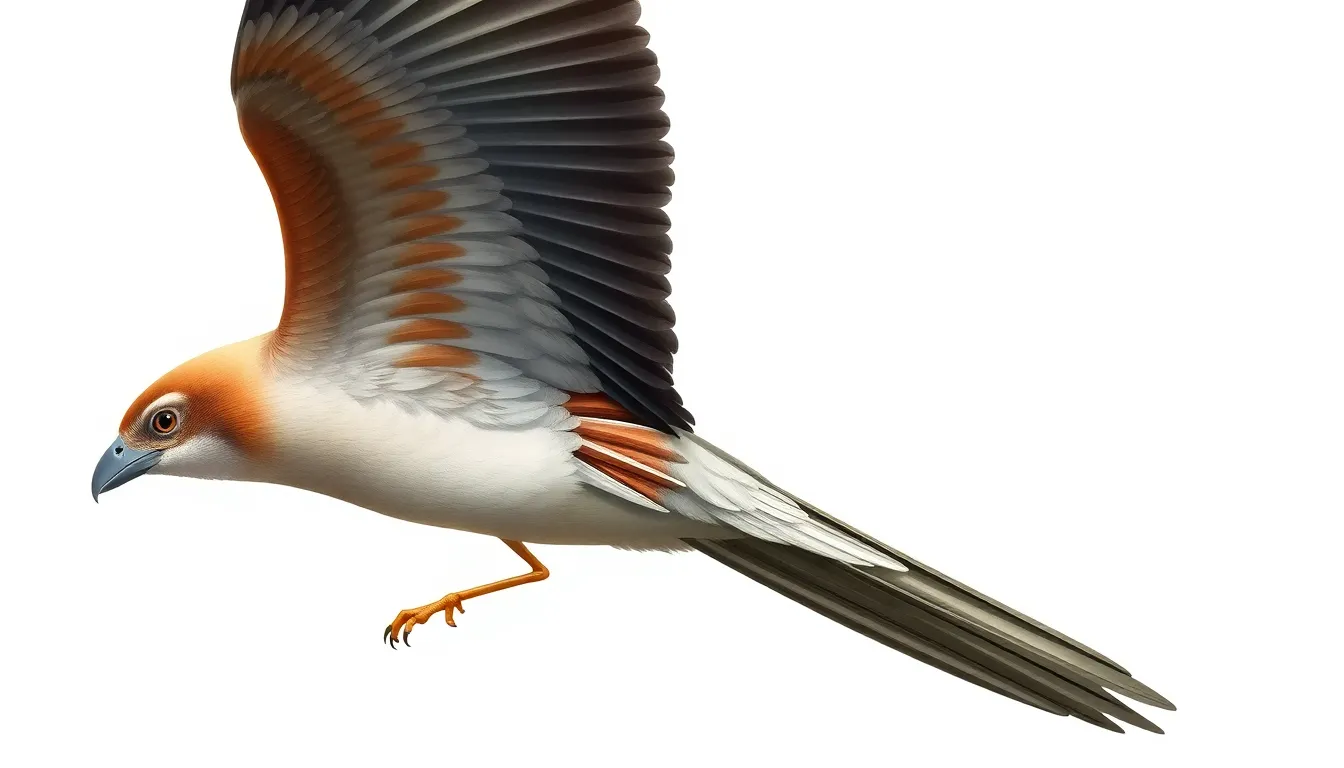
Wing anatomy transforms birds into aerial masters through sophisticated aerodynamic principles and structural adaptations. The intricate interplay between feathers, bones, and muscles creates the conditions necessary for sustained flight across diverse environments.
Lift Generation Mechanisms
Bird wings generate lift through the combined effects of airfoil shape and angle of attack adjustments. The cambered wing profile creates differential air pressure as airflow moves faster over the curved upper surface than the flatter lower surface. This pressure differential produces the upward force that counters gravity and enables birds to remain airborne.
Primary flight feathers create the wing’s leading edge and control thrust vectoring during the downstroke. Secondary flight feathers form the wing’s cambered trailing edge and maintain consistent airflow patterns across the wing surface. The alula functions as a miniature wing slot that prevents airflow separation during low-speed maneuvers and steep angle approaches.
Wing flexibility allows birds to adjust camber throughout the flight cycle for optimal lift production. Patagial muscles modify wing curvature in real time while digital flexor muscles control individual feather angles. These adjustments optimize lift generation across varying flight speeds and atmospheric conditions.
Vortex control occurs through specialized feather positioning that manages wingtip turbulence. Primary feathers separate at the wingtips to create individual vortices that reduce drag and improve lift efficiency. This feather slotting mechanism appears in soaring species like eagles and hawks that rely on thermal lift for extended flight periods.
Wing Loading and Efficiency
Wing loading represents the ratio of body weight to wing surface area and determines flight characteristics across bird species. Lower wing loading enables easier takeoff and enhanced maneuverability while higher wing loading supports faster flight speeds and reduced energy expenditure during cruising.
| Wing Loading Category | Weight to Area Ratio | Flight Characteristics | Example Species |
|---|---|---|---|
| Low Loading | 0.3-0.8 oz/in² | Quick takeoff, high maneuverability | Hummingbirds, wrens |
| Moderate Loading | 0.8-1.5 oz/in² | Balanced performance | Robins, sparrows |
| High Loading | 1.5-3.0 oz/in² | Fast cruising, efficient soaring | Falcons, swifts |
Aspect ratio calculations compare wing length to wing width and influence flight efficiency patterns. High aspect ratio wings maximize lift to drag ratios for soaring and long distance migration. Low aspect ratio wings provide rapid acceleration and tight turning capabilities in cluttered environments.
Wing tip design affects efficiency through vortex management and drag reduction mechanisms. Pointed wing tips minimize induced drag during high speed flight while slotted wing tips reduce turbulence during slow flight maneuvers. Rounded wing tips optimize performance for quick direction changes and obstacle avoidance.
Flight muscle efficiency correlates directly with wing design parameters and metabolic energy requirements. The pectoralis major generates consistent power output that matches wing loading demands while supracoracoideus muscles provide precise upstroke control. Muscle fiber composition varies between species based on their exact flight requirements and energy management strategies.
Evolutionary Adaptations in Wing Design
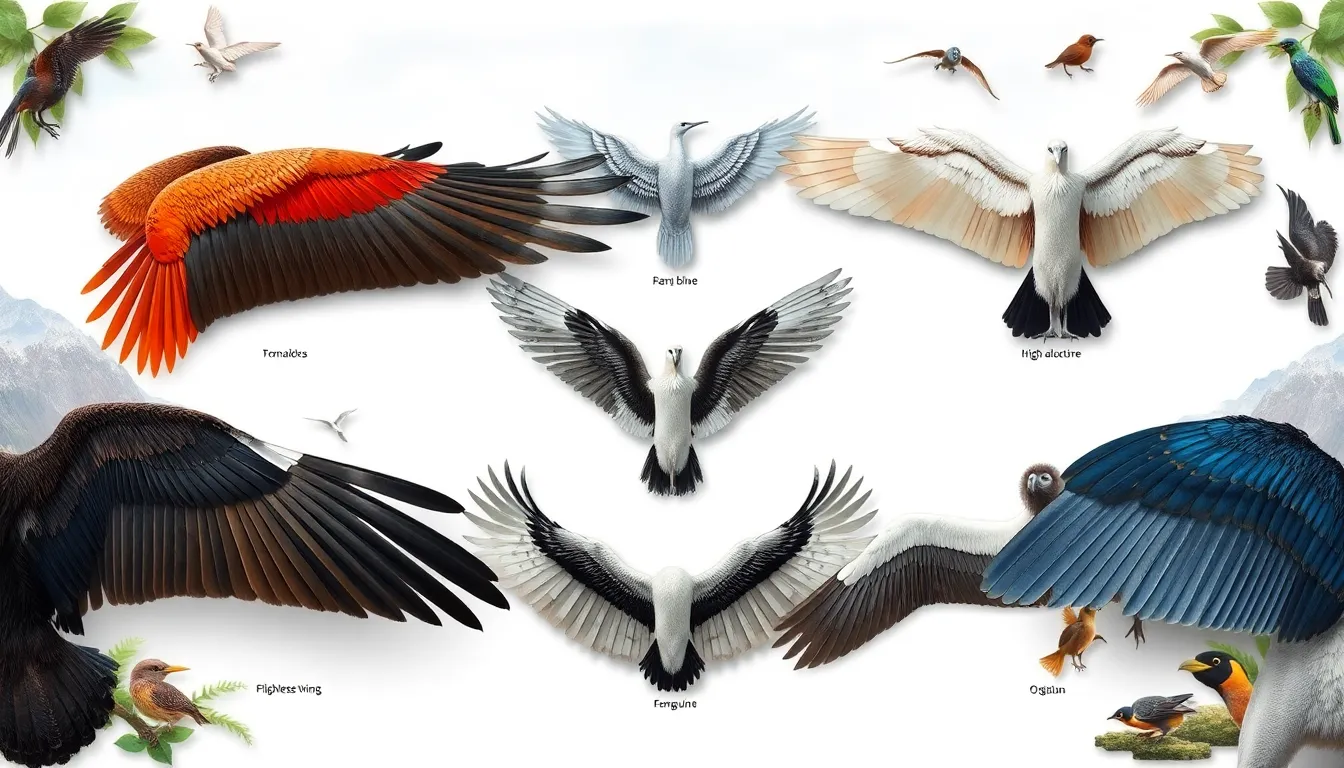
Wing design reflects millions of years of evolutionary refinement customized to exact ecological demands and environmental challenges. These adaptations demonstrate how natural selection optimizes flight performance for diverse habitats and lifestyle requirements.
Specialized Wings for Different Environments
Arctic birds develop enhanced insulation through dense feather layers that maintain aerodynamic efficiency while protecting against extreme cold temperatures. Thick down underlayers combine with specialized contour feathers to create thermal barriers without adding important weight penalties.
Tropical rainforest species exhibit compact wing structures optimized for handling dense vegetation and tight aerial spaces. Short rounded wings provide exceptional maneuverability between branches while maintaining quick acceleration capabilities for escape responses.
Desert dwelling birds feature wings with specialized feather arrangements that minimize heat absorption during extended soaring flights. Light colored feather tips reflect solar radiation while maintaining structural integrity across temperature extremes ranging from 40°F to 120°F.
Coastal and marine birds develop waterproof wing surfaces through unique feather microstructures that repel moisture and salt spray. These adaptations include:
- Tightly interlocked barb structures preventing water penetration
- Specialized preen gland secretions improving water resistance
- Modified wing angles reducing splash impact during surface hunting
- Extended primary feathers enabling efficient gliding over ocean swells
High altitude species possess enlarged wing surfaces compensating for reduced air density at elevations exceeding 15000 feet. Extended wingspan measurements and modified feather density create adequate lift generation in thin atmospheric conditions.
Flightless Bird Wing Modifications
Flightless birds demonstrate remarkable wing transformations serving functions beyond aerial locomotion through specialized anatomical modifications. These species retain wing structures while adapting them for terrestrial survival strategies.
Penguin wings evolved into powerful underwater propulsion systems with solid bone structures replacing hollow pneumatic bones found in flying birds. Dense muscle mass concentrated around modified wing joints generates thrust forces exceeding 40 pounds per square inch during underwater pursuit hunting.
Ostrich wings function as sophisticated thermoregulation and communication devices measuring up to 6 feet in span. Large surface areas help heat dissipation through controlled feather positioning while dramatic wing displays communicate territorial boundaries and mating readiness.
Running birds like emus use wings for balance and steering during high speed terrestrial locomotion reaching speeds of 30 mph. Modified wing positioning provides gyroscopic stability and directional control during rapid direction changes and obstacle avoidance.
Cassowary wings feature reduced feather coverage with exposed shaft structures creating defensive weapons for territorial protection. These modified wings generate intimidating displays while maintaining balance functions during aggressive encounters.
| Flightless Species | Wing Length | Primary Function | Specialized Feature |
|---|---|---|---|
| Emperor Penguin | 12 inches | Underwater propulsion | Solid bone structure |
| Ostrich | 6 feet | Thermoregulation | Massive surface area |
| Emu | 24 inches | Balance/steering | Gyroscopic positioning |
| Cassowary | 18 inches | Defense/display | Exposed shaft weapons |
Kiwi wings represent extreme reduction with vestigial structures measuring only 2 inches in length while maintaining essential muscle attachment points for upper body stability. These tiny appendages demonstrate how evolutionary pressure eliminates unnecessary flight apparatus while preserving critical anatomical connections.
Conclusion
Understanding bird wing anatomy reveals nature’s incredible engineering prowess. We’ve explored how every component—from hollow bones to specialized feathers—works together to create the perfect flying machine.
These anatomical marvels showcase millions of years of evolutionary refinement. Whether it’s the soaring albatross with its high aspect ratio wings or the hummingbird’s rapid-beat elliptical design each species has developed the ideal wing structure for its lifestyle.
The intricate relationship between wing loading aspect ratio and muscle efficiency demonstrates that flight isn’t just about having wings—it’s about having the right wings for the job. From Arctic adaptations to flightless innovations birds continue to inspire our understanding of aerodynamics and biological design.
Frequently Asked Questions
What are the main components of bird wing anatomy?
Bird wings consist of three primary regions: the humerus (upper arm), radius and ulna (forearm), and the hand section with specialized bones. The wing structure includes primary flight feathers for thrust, secondary flight feathers for lift, and hollow pneumatic bones that reduce weight while maintaining strength for flight.
How do different wing shapes affect bird flight capabilities?
There are four main wing types: elliptical wings for quick maneuverability in forests, high aspect ratio wings for efficient soaring, swept-back wings for high-speed flight, and broad wings for gliding. Each shape corresponds to specific ecological niches and flight requirements of different bird species.
What is wing loading and how does it impact flight performance?
Wing loading is the ratio of a bird’s body weight to its wing surface area. Low wing loading allows easy takeoff and tight maneuverability, moderate wing loading provides balanced flight characteristics, while high wing loading enables fast, efficient cruising but requires more energy for takeoff and turning.
How do flight feathers contribute to aerodynamics?
Primary flight feathers generate thrust during downstrokes, secondary feathers create the wing’s cambered shape for lift, and tertiary feathers smooth airflow to prevent turbulence. Contour feathers reduce drag by creating a streamlined surface, while specialized alula feathers prevent stalling during slow flight.
What role do flight muscles play in wing movement?
The pectoralis major muscle powers the downstroke for lift and thrust, while the supracoracoideus muscle controls the upstroke. These muscles adapt to different flight styles, with powerful muscles in birds requiring strong thrust and more efficient muscles in species focused on sustained flight.
How have flightless birds adapted their wings for other purposes?
Flightless birds have evolved wings for various non-aerial functions. Penguins use their wings for underwater propulsion, ostriches for thermoregulation and communication, emus for balance while running, and cassowaries for defense. These adaptations demonstrate the versatility of wing structures beyond flight.
What environmental adaptations exist in wing design?
Birds have specialized wing adaptations for different environments: Arctic species have insulation features, tropical birds possess compact wings for forest maneuverability, desert birds minimize heat absorption, coastal species have waterproof surfaces, and high-altitude birds feature enlarged wings for thin-air lift generation.

